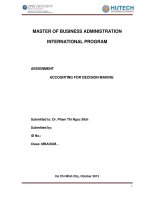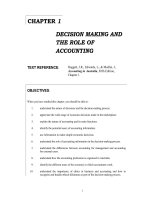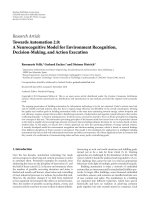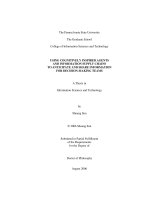Accounting for decision making and control
Bạn đang xem bản rút gọn của tài liệu. Xem và tải ngay bản đầy đủ của tài liệu tại đây (45.36 KB, 11 trang )
Accounting for
Decision Making and Control
Outline of Chapter 1
Introduction
• Purposes of Managerial Accounting
– Planning/Decision Making
– Control
• Financial vs. Managerial Accounting
• Design of Accounting System
– Design and Use of Systems
– Evolution
• Example of Decision Making
Planning/Decision Making
• Choosing goals, predicting results under various
alternatives, making the decision
• Examples:
– Product Management: Add a new product, terminate
an existing product line, accept/reject a special order
– Pricing: Set selling price (profit or cash flow)
– Cost control: Add equipment, change production
process, make or buy (outsource)
Control
• Implementing the action
• Evaluating the performance of personnel
and operations
• Goal: To ensure that the organization
operates in the intended manner
Objectives of Managerial
Accounting
• To provide information for decision making
• To assist in controlling operations
• To motivate employees toward achieving
the organization’s goals
• To measure the performance of employees
or subunits of the organization
Distinction Between Financial
and Managerial Accounting
• Financial Accounting
– Used by shareholders, bondholders, taxing
authorities, regulatory bodies, etc.
– Rule-oriented, general purpose reports
• Managerial Accounting
– Used by managers - internal to firm
– Focuses on the internal needs of managers
(planning/decision making, performance evaluation)
Design - Foundation
• Economic perspective
• Assumptions
– Self-interested employees - maximize their own selfinterest
– Owners want to maximize firm value
– Maximizing profits maximizes firm value
• Goal: To design performance incentives based on
accounting measures to motivate employees to take
actions that maximize firm value
Design - Conflicting Goals
• Decision Making
– Want to avoid distorted information
– Desire estimates to plan future activities
• Control
– Need incentives to motivate behavior changes
– Tendency to ignore information not specifically
included in the system
– Desire to report “good” numbers to satisfy top
management
Design - Evolution
• Economic Darwinism
– Over the long term, systems survive in
competitive markets when the benefits exceed
or equal the costs of maintaining those systems.
• Survival does not imply optimality
– Better systems may exist, but have not yet been
discovered.
Quote - p.11: Different Costs
for Different Purposes
• Points:
– No single cost figure is superior to all others
– All systems involve tradeoffs between decision
making and control
– Many decisions/choices are arbitrary - don’t be
afraid to challenge/critique any systems that
we’ve discussed.
Vortec Example
• Trade-off between decision management and
decision control
• Beware of unit costs
• Use opportunity costs
• Supplement accounting data with other
information
• Basing rewards on accounting information may
be dangerous









